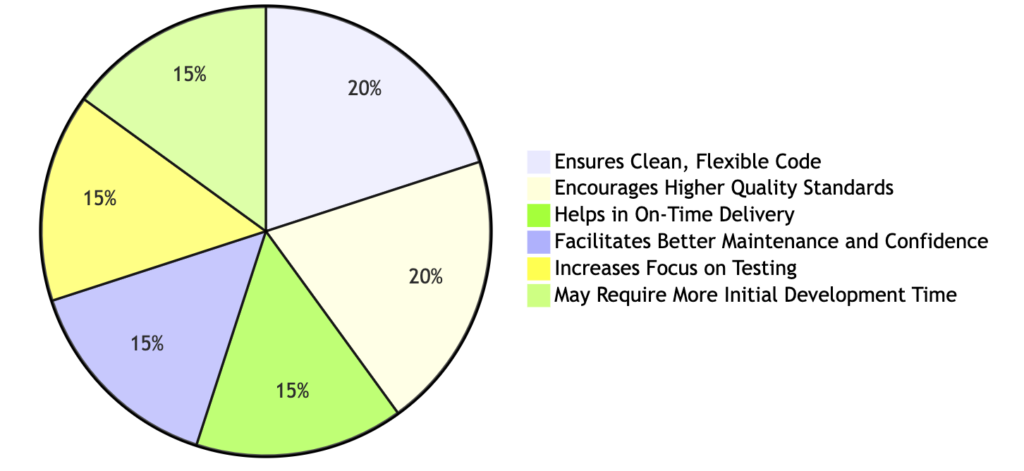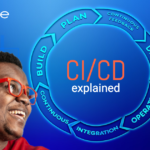Test-driven development (TDD) is a crucial process in software development that helps engineers create high-quality code and build robust applications. In this article, we will explore five essential facts about TDD that every engineer should know.
Components of Professionalism Impacted by TDD

TDD is changing the game by ensuring higher quality code, promoting a stronger focus on testing, and ultimately making developers’ lives a bit easier (yes, really!). But what does the impact of TDD look like when we break it down? Let’s explore the slices of the TDD pie and see how they contribute to the overall cake of professionalism in software development.
The TDD Impact Breakdown
Ensures Clean, Flexible Code (20%)
At the heart of TDD lies the mantra of clean, manageable code. By nudging developers to write small, testable chunks, TDD fosters a modular approach that’s akin to keeping your workspace tidy. Imagine your code as a set of neatly stacked boxes, each labeled and easy to sift through. That’s the orderliness TDD brings to the table, making it a hefty slice of the pie.
Helps in On-Time Delivery (15%)
Time is of the essence in software development, and TDD plays a surprising role in keeping the clocks ticking favorably. Initially, it might seem like TDD is slowing things down—what with all the test writing before the actual coding. However, this upfront time investment pays dividends by reducing bug fixes and debugging sessions down the line. It’s the tortoise approach, slow and steady wins the race, granting it a solid stake in our pie.
Encourages Higher Quality Standards (20%)
Quality is non-negotiable, and TDD places it right at the forefront. Starting with tests sets a high bar for code correctness, driving developers to meet it with each line they write. This commitment to excellence is why quality standards own a hefty chunk of the TDD pie. It’s not just about making things work; it’s about making them work well.
Facilitates Better Maintenance and Confidence (15%)
Ever felt the dread of returning to a codebase months later and deciphering what past-you was thinking? TDD eases that pain. The comprehensive test suite acts as both a safety net and a documentation guide, making code maintenance less of a headache and boosting developer confidence. Knowing your code is well-tested brings peace of mind, earning this aspect its fair share of the pie.
Increases Focus on Testing (15%)
TDD is a cultural shift, placing testing at the core of development rather than an afterthought. This focus ensures that testing becomes a natural part of the development rhythm, akin to breathing for a developer. It’s a fundamental change in how projects are approached, deserving a significant portion of our TDD pie.
May Require More Initial Development Time (15%)
Adopting TDD isn’t without its challenges, primarily the initial slowdown as developers get into the groove of test-first coding. This early investment in time can be daunting, but as they say, good things come to those who wait—or in this case, to those who test. Acknowledging this aspect is crucial, rounding out our TDD pie.
Now lets look at 5 Facts and usecases to better understand TDD.
Fact 1: TDD is a development process, not a testing one
TDD is often misunderstood as a testing technique, but it is much more than that. It is a development process that follows an iterative cycle of writing tests, then code, and repeating the cycle. By writing tests first, engineers can design better software and improve overall code quality. TDD helps catch bugs early in the development process, reducing the time and effort spent on debugging later on.
- Improved Design: By focusing on writing tests first, the design of the authentication system is driven by functionality and reliability, leading to cleaner, more modular code.
- Early Bug Detection: Bugs are caught at the moment they are introduced, significantly reducing debugging time later in the project.
- Documentation: The tests serve as live documentation for the system. They clearly express what the code is supposed to do, making it easier for new team members to understand the project.
Use Case: Building a User Authentication System
Background: Imagine we’re part of a development team tasked with creating a user authentication system for a new web application. This system needs to securely manage user logins, registrations, and session management. Given the critical importance of security and reliability in authentication systems, this scenario is ripe for applying TDD to ensure high-quality code from the outset.
Step 1: Requirement Analysis and Test Case Creation
Before writing any code, we start by thoroughly understanding the requirements for the authentication system. We then proceed to write test cases based on these requirements. For instance:
- Test Case 1: Ensure that a user can register with a username and password.
- Test Case 2: Ensure that a user cannot register with an already taken username.
- Test Case 3: Verify that a user can log in with valid credentials.
- Test Case 4: Verify that logging in with invalid credentials fails.
Step 2: Writing the First Test
We pick the first test case (user registration) and write a simple test. Initially, this test will fail because we haven’t implemented the feature yet. This is the red phase of the TDD cycle.
Step 3: Writing the Minimum Code to Pass the Test
We now write the minimum amount of code needed to make the first test pass. This may involve creating a basic registration function that accepts a username and password. This is the green phase of the TDD cycle.
Step 4: Refactor
With the test passing, we look at our code and consider if there’s a better way to structure it without changing its behavior. This might involve renaming variables for clarity, removing duplication, or other improvements. This is the refactor phase of the TDD cycle.
Step 5: Repeat the Cycle
We move on to the next test case, ensuring that users cannot register with a taken username. We write a test, see it fail, implement the feature, and then refactor. This cycle continues for each test case, gradually building up the functionality of the authentication system.
Fact 2: TDD reduces technical debt and bugs
Technical debt refers to the cost of additional work caused by taking shortcuts or making compromises during the development process. TDD helps reduce technical debt by providing a safety net for new features and changes. By writing tests before writing code, engineers ensure that their changes do not introduce new bugs or break existing functionality. Tests also serve as documentation, making it easier for developers to understand and modify code in the future.
Use Case: Refactoring a Legacy Codebase for a Shopping Cart System
Background: Consider we are part of a team tasked with updating and adding new features to a legacy shopping cart system for an e-commerce platform. The system has been in use for years, accumulating technical debt due to various shortcuts and compromises made in the past for quick deliveries. The codebase has become difficult to understand and modify, and introducing new features without breaking existing functionality is challenging.
Objective: Our goal is to refactor the shopping cart system to improve its code quality and implement new features, such as adding new payment options and improving the checkout process, while ensuring we don’t introduce new bugs.
Step 1: Analyzing the Existing System and Writing Tests
Our first step is to analyze the current state of the shopping cart system. We identify critical functionalities that need to be preserved and areas where new features are to be added. Before making any changes, we start writing tests for existing functionality. For instance:
- Test Case 1: Ensure that items can be added to the shopping cart.
- Test Case 2: Ensure that the total price is updated correctly when items are added or removed.
- Test Case 3: Verify that the checkout process completes successfully with valid payment information.
Step 2: Ensuring a Safety Net
These tests serve as a safety net, allowing us to refactor and add new features with confidence. Initially, most of these tests will pass since they are designed to match the current functionality. However, they are crucial for the next steps.
Step 3: Incrementally Refactoring and Adding Features
With our tests in place, we start the iterative process of refactoring the codebase. We make small, manageable changes and run our tests frequently to ensure that we haven’t introduced any regressions or new bugs. For example, when we refactor the method for adding items to the cart to make it more efficient or when we add a new feature like support for a new payment method, we write tests first to define the expected behavior, then implement the changes.
Step 4: Continuous Testing and Documentation
As we proceed, the tests continue to serve multiple purposes: they ensure that our changes do not break existing functionality, they document the intended behavior of the system for future developers, and they help identify areas of the code that are fragile and in need of improvement.
Fact 3: TDD is not just for unit tests but also integration testing
TDD can be applied to various types of tests, including unit tests and integration tests. Unit tests focus on testing individual components or functions in isolation, while integration tests verify the interaction between different components. Both types of tests are important in a well-rounded testing strategy. TDD ensures that tests are written before the code, promoting a more thorough and reliable testing process.
Dedicated Full Stack Developers
Hiring Full Stack developers gives businesses access to pros proficient in various technologies and frameworks. Their versatility streamlines collaboration, leading to faster development and enhanced efficiency.
Use Case: Developing a New Feature for a Collaboration Platform
Background: Imagine we’re working on a collaboration platform similar to Slack or Microsoft Teams. Our task is to develop a new feature that allows users to create, join, and manage virtual meeting rooms. This feature involves multiple components: a user interface for managing meetings, backend services for handling meeting data, and integration with external video conferencing services.
Objective: Implement the new meeting room feature with a focus on reliability and easy maintainability, leveraging TDD to guide the development process from the ground up.
Step 1: Identifying Components and Writing Unit Tests
First, we break down the feature into smaller, manageable components. For each component, we write unit tests that define the expected behavior. For example:
- Component 1: Meeting Room Creation
Unit Test 1: Ensure that a user can create a meeting room with a name and description.
Unit Test 2: Verify that a meeting room cannot be created with invalid inputs (e.g., empty name). - Component 2: Joining a Meeting Room
Unit Test 1: Ensure that a user can join an existing meeting room by ID.
Unit Test 2: Verify that an error is returned when trying to join a non-existent room.
Step 2: Writing the Minimum Code to Pass Unit Tests
For each unit test, we then write the minimal amount of code required to pass the test. This iterative process ensures that each component behaves exactly as intended in isolation.
Step 3: Writing Integration Tests
Once the unit tests are passing for individual components, we shift focus to how these components interact. We write integration tests to cover scenarios involving multiple components working together. For instance:
- Integration Test 1: Verify that when a user creates a meeting room, they are automatically joined to that room.
- Integration Test 2: Ensure that a list of participants updates in real-time when users join or leave a meeting room.
Step 4: Implementing Code to Pass Integration Tests
We implement or refine the system’s code to ensure that integration tests pass, confirming the correct interaction between components. This may involve adjusting how components communicate with each other or fixing any issues that prevent the system from working as a cohesive whole.
Fact 4: TDD supports continuous integration and delivery
Continuous integration (CI) and continuous delivery (CD) are practices that involve frequently integrating code changes and delivering software in small, incremental updates. TDD plays a crucial role in supporting these practices by providing a large test suite that runs continuously. With TDD, engineers can quickly identify and fix issues, leading to faster feedback and fewer bugs in the final product.
Use Case: Implementing CI/CD for a Financial Reporting System
Background: Consider we’re part of a team responsible for a financial reporting system used by large corporations. This system requires high accuracy, reliability, and timely updates to handle various financial operations and reporting standards. The business landscape demands that new features and updates be rolled out swiftly to adapt to changing regulations and customer needs.
Objective: Enhance the development process to enable rapid, safe deployments of new features and updates, leveraging TDD to facilitate CI/CD practices.
Step 1: Establishing a TDD Workflow
Initially, the team adopts a TDD approach for new features and bug fixes. For every task:
- Write tests first: Define expected behaviors through tests before any new code is written.
- Implement features: Write code to pass the tests, ensuring that each new feature meets its specifications.
- Refactor: Improve the code without altering its functionality, guided by tests to ensure no regressions.
Step 2: Setting Up Continuous Integration (CI)
With TDD providing a robust suite of tests, the team sets up a CI pipeline. This pipeline automatically runs all tests against the codebase whenever new commits are pushed to the version control system. Key components include:
- Automated builds: Compile the code and check for integration issues.
- Automated testing: Run the entire suite of unit and integration tests to ensure that recent changes haven’t broken any existing functionality.
Step 3: Implementing Continuous Delivery (CD)
Building on the CI foundation, the team implements a CD pipeline that automates the delivery of code changes after they pass all tests. This involves:
- Automated deployment to staging: Push code changes to a staging environment that closely mimics production.
- Automated testing in staging: Conduct further tests, including performance and security tests, to ensure the changes are safe for production.
- Manual approval for production: Once all automated checks pass, a manual review process before final deployment ensures an additional layer of scrutiny.
Step 4: Monitoring and Feedback
After deployment, the system is closely monitored. Feedback from monitoring tools and users is quickly incorporated into new tests and code changes, maintaining the cycle of TDD and CI/CD.
Benefits Realized:
- Rapid Iteration: The combination of TDD and CI/CD allows the team to make and deploy changes quickly, knowing that each change is automatically tested and validated.
- High Quality and Reliability: Continuous testing significantly reduces the likelihood of bugs reaching production, ensuring the financial reporting system remains accurate and dependable.
- Efficient Feedback Loop: Issues are identified and addressed early in the development cycle, reducing the cost and effort of fixing bugs in later stages.
Would you like to get engaged with professional Specialists?
We are a software development team with extensive development experience in the Hybrid and Crossplatform Applications development space. Let’s discuss your needs and requirements to find your best fit.
Fact 5: TDD is not a silver bullet and requires a learning curve
While TDD offers numerous benefits, it is not a magical solution that solves all software development challenges. Implementing TDD effectively requires a learning curve, and engineers may face challenges along the way. Common pitfalls include overtesting, writing brittle tests, and struggling to find the right balance between test coverage and development speed. However, with practice and continuous learning, engineers can overcome these challenges and reap the rewards of TDD.
Use Case: Developing a Custom CRM System
Background: Suppose we are part of a development team tasked with building a custom Customer Relationship Management (CRM) system tailored to the unique needs of a mid-sized sales organization. This CRM system requires a range of functionalities, from managing customer data to tracking sales opportunities and generating reports.
Objective: Implement TDD in the development of the CRM system, while identifying and addressing common pitfalls associated with TDD.
Step 1: Kickstarting TDD
The team begins by adopting TDD for the CRM system’s development. Initial enthusiasm leads to a comprehensive suite of tests for every conceivable functionality. However, the team soon encounters several common pitfalls.
Challenges Encountered:
- Overtesting: The team finds themselves writing tests for trivial functionalities, which adds to the development time without significantly improving code quality.
- Brittle Tests: Some tests are too closely tied to the implementation details, causing them to break every time the code is refactored, even if the functionality remains unchanged.
- Balancing Act: Striking the right balance between achieving high test coverage and maintaining development speed becomes a challenge, with the team often swinging to extremes.
Step 2: Reflecting and Adjusting
Realizing the inefficiencies, the team takes a step back to reflect on their TDD practice and make necessary adjustments.
Strategies Implemented:
- Prioritize Testing for Business Logic: The team decides to focus their testing efforts on complex business logic and areas with high risk of bugs, reducing the emphasis on trivial and unlikely-to-change areas.
- Make Tests More Resilient: Efforts are made to write tests that focus on the behavior of the code rather than its implementation details, making them less brittle and more adaptable to changes.
- Adopt a Balanced Approach: The team seeks a middle ground by setting realistic goals for test coverage that ensure quality without unduly slowing down development. They also start incorporating code review sessions focused on evaluating the necessity and quality of tests.
Step 3: Learning and Evolving
As the CRM system development progresses, the team continuously learns from their experiences. They become more adept at identifying when to write tests and how to write effective ones. Regular retrospectives help the team share insights and strategies for overcoming TDD challenges.
How To Learn TDD
Here’s a selection of popular and informative links to get you started on your TDD journey:
- An Introduction to Test-Driven Development on freeCodeCamp: Offers a practical approach to TDD with examples in JavaScript, focusing on the jest testing framework. This guide breaks down the process of writing a test, running it to see it fail (Red), writing the minimum code to make the test pass (Green), and then refactoring (Refactor). It’s an excellent place to start for beginners.
- Introduction to Test-Driven Development (TDD) with Classic TDD Example by Khalil Stemmler: This resource provides an insightful look into the TDD process, emphasizing the importance of the Red-Green-Refactor loop. It discusses the value of feedback, exposing bad design, and the uncertainty as early as possible in the development cycle.
- A simple introduction to Test Driven Development with Python on freeCodeCamp: A focused tutorial that walks through TDD using Python. It starts with simple functions and gradually introduces more complex test cases, demonstrating how TDD facilitates building up functionality in small, manageable increments.
- TDD Full Course (Learn Test Driven Development with Python) – YouTube: A comprehensive video tutorial that guides viewers through building an application from scratch using TDD with Python. It’s perfect for those who prefer learning through video content and looking for a more in-depth explanation.
- GitHub – veilair/test-driven-development: A curated list of frameworks, books, articles, talks, screencasts, recordings, libraries, learning tutorials, and resources about TDD. It’s a goldmine for anyone looking to dive deep into TDD resources across different programming languages.
These resources cover a wide range of topics within TDD, from basic principles and processes to specific examples in various programming languages.
Test-driven development is a powerful process that helps engineers build high-quality software with reduced technical debt and bugs. By following the TDD approach, engineers can design better software, improve code quality, and support continuous integration and delivery. While TDD may have a learning curve, the benefits it offers make it a valuable technique for any software development team.
Give TDD a try and explore its benefits firsthand!









